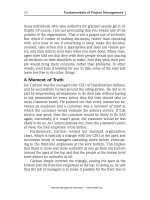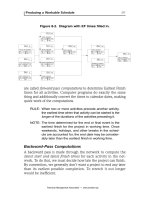Exploring management 6th by schermerhornch04
Bạn đang xem bản rút gọn của tài liệu. Xem và tải ngay bản đầy đủ của tài liệu tại đây (523.68 KB, 41 trang )
Exploring
Management
John Schermerhorn, Jr. and Daniel G. Bachrach
Sixth Edition
Chapter 4
Managers as Decision Makers
There is No Substitute for a Good
Decision
“Estamos bien en el réfugio
– los 44.” For 69 days shift
leader Luis Urzua kept the
men trapped in the Chilean
mine organized and
hopeful. On the 70th day,
he was the last man safely
out.
Copyright ©2018 John Wiley & Sons, Inc.
2
Your Chapter 4 Takeaways
• How do managers use information to solve
problems? (4.1)
• What are the five steps in the decision-making
process? (4.2)
• What are current issues in managerial decision
making? (4.4)
Copyright ©2018 John Wiley & Sons, Inc.
3
USING INFORMATION TO SOLVE PROBLEMS 4.1
Takeaway 4.1 – answers to come
• Managers use technological, informational, and analytical
competencies to solve problems.
• Managers deal with problems posing threats and offering
opportunities.
• Managers can be problem avoiders, problem solvers, or problem
seekers.
• Managers make programmed and non-programmed decisions.
• Managers use both systematic and intuitive thinking.
• Managers use different cognitive styles to process information for
decision making.
• Managers make decisions under conditions of certainty, risk, and
uncertainty.
Copyright ©2018 John Wiley & Sons, Inc.
4
USING INFORMATION TO SOLVE PROBLEMS 4.1
Managers Use Competencies to Solve
Problems
• Information competency - the ability to locate,
retrieve, evaluate, organize, and analyze information
to make decisions that solve problems
• Technological competency – the ability to
understand new technologies and use them to their
best advantage.
• Analytical competency – the ability to evaluate and
analyze information to find
Copyright ©2018 John Wiley & Sons, Inc.
5
USING INFORMATION TO SOLVE PROBLEMS 4.1
Problems Pose Threats and Opportunities
Figure 4.1 In What Ways Do
Managers Serve as Information
Nerve Centers in Organizations?
Copyright ©2018 John Wiley & Sons, Inc.
6
USING INFORMATION TO SOLVE PROBLEMS 4.1
Problems Pose Threats and Opportunities
• Problem Solving
• Identifying and taking action to solve problems
• Knowledge Workers
• Use information to solve problems, describes managers
well
• Performance Threat
• A situation where something is wrong or likely to be
wrong
• Performance Opportunity
• A situation that offers the possibility of a better future,
if the right steps are taken
Copyright ©2018 John Wiley & Sons, Inc.
7
USING INFORMATION TO SOLVE PROBLEMS 4.1
Problem Solving Approaches
• Problem avoiders – prefer not to make decisions and
ignore problems
• Problem solvers – react to problems as they occur
• Problem seekers – proactive in anticipating threats
and opportunities
Copyright ©2018 John Wiley & Sons, Inc.
8
USING INFORMATION TO SOLVE PROBLEMS 4.1
Types of Decisions
• A decision is a choice among possible alternative
courses of action.
• Programmed decisions
• applies a solution from past experience to a
routine problem
• Non-programmed decisions
• applies a specific solution crafted for a unique
problem
Copyright ©2018 John Wiley & Sons, Inc.
9
USING INFORMATION TO SOLVE PROBLEMS 4.1
Approaches to Problem Solving
• Systematic Thinking
• Approaches problems in a rational and
analytical fashion.
• Intuitive Thinking
• Approaches problems in a flexible and
spontaneous fashion.
Copyright
©2018
JohnJohn
WileyWiley
& Sons,&Inc.
Copyright
©2018
Sons, Inc.
10
USING INFORMATION TO SOLVE PROBLEMS 4.1
Problem Solving Approaches
Managers use different cognitive styles
Copyright
©2018
Sons, Inc.
Copyright
©2018
JohnJohn
WileyWiley
& Sons,&Inc.
11
USING INFORMATION TO SOLVE PROBLEMS 4.1
Problem Solving Environments
Managers make decisions under various types of
environments
Figure 4.2 What Are the Differences Between Certain,
Risk, and Uncertain Decision-Making Environments?
Copyright ©2018 John Wiley & Sons, Inc.
12
USING INFORMATION TO SOLVE PROBLEMS 4.1
Study Guide for Takeaway 4.1
Rapid Review:
• A problem can occur as a threat or an opportunity; it involves an existing or potential
discrepancy between an actual and a desired state of affairs.
• Managers can deal with structured and routine problems using programmed decisions;
novel and unique problems require special solutions developed by non-programmed
decisions.
• Managers deal with problems in different ways, with some being problem avoiders,
others being reactive problem solvers, and still others being proactive problem seekers.
• Managers using systematic thinking approach problems in a rational step-by-step
fashion; managers using intuitive thinking approach them in a more flexible and
spontaneous way.
• Managers display different cognitive styles when dealing with information for decision
making—sensation thinkers, intuitive thinkers, intuitive feelers, and sensation feelers.
• The problems that managers face occur in environments of certainty, risk, and
uncertainty.
Copyright ©2018 John Wiley & Sons, Inc.
13
USING INFORMATION TO SOLVE PROBLEMS 4.1
Study Guide for Takeaway 4.1
Questions for Discussion:
1. Can a manager be justified for acting as a
problem avoider in certain situations?
2. Would an organization be better off with mostly
systematic or mostly intuitive thinkers?
3. Is it possible to develop programmed decisions
for use in conditions of risk and uncertainty?
Copyright ©2018 John Wiley & Sons, Inc.
14
USING INFORMATION TO SOLVE PROBLEMS 4.1
Be Sure You Can…for Takeaway 4.1
• explain the importance of information competency for
successful problem solving
• differentiate programmed and nonprogrammed decisions
• describe different ways managers approach and deal with
problems
• discuss the differences between systematic and intuitive
thinking
• identify differences between the four cognitive styles used in
decision making
• explain the challenges of decision making under conditions of
certainty, risk, and uncertainty environments
Copyright ©2018 John Wiley & Sons, Inc.
15
THE DECISION MAKING PROCESS 4.2
Takeaway 4.2 – answers to come
• Step 1 is to identify and define the problem.
• Step 2 is to generate and evaluate alternative
courses of action.
• Step 4 is to decide on a preferred course of action.
• Step 4 is to implement the decision.
• Step 5 is to evaluate results.
• Ethical reasoning is important at all steps in
decision making.
Copyright ©2018 John Wiley & Sons, Inc.
16
THE DECISION MAKING PROCESS 4.2
Steps in the Decision Making Process
Figure 4.3 What Are Five Steps in the Decision-Making Process?
Copyright ©2018 John Wiley & Sons, Inc.
17
THE DECISION MAKING PROCESS 4.2
Step 1 – Identify and Define the Problem
• Gather information and decide what should
be accomplished
• Common mistakes include
• Defining problem too broadly or too narrowly
• Focusing on symptoms instead of causes
• Choosing the wrong problem to deal with
Copyright ©2018 John Wiley & Sons, Inc.
18
THE DECISION MAKING PROCESS 4.2
Step 2 – Generate And Evaluate Alternatives
• Who are the stakeholders and how will the
alternatives affect them?
• Criteria for evaluating alternatives
• Cost benefit analysis
• Timeliness
• Acceptability
• Ethical soundness
Copyright ©2018 John Wiley & Sons, Inc.
19
THE DECISION MAKING PROCESS 4.2
Step 3 – Decide on a Preferred Course of Action (cont.)
• Two different outcomes
• Behavioral model leads to satisficing decisions –
choosing the first solution that appears satisfactory
• Classical model leads to optimizing decisions – the
absolute best solution to the problem
Copyright ©2018 John Wiley & Sons, Inc.
20
THE DECISION MAKING PROCESS 4.2
Step 3 – Decide on a Preferred Course
of Action
FIGURE 4.4 How Does the Classical Model of Managerial Decision
Making Differ from the Behavioral Model?
Copyright ©2018 John Wiley & Sons, Inc.
21
THE DECISION MAKING PROCESS 4.2
Step 4 – Implement the Decision
• Take action on the selected alternative
• Lack-of-participation error occurs when
parties necessary for supporting the
decision were not included in the process
Copyright ©2018 John Wiley & Sons, Inc.
22
THE DECISION MAKING PROCESS 4.2
Step 5 – Evaluate Results
• Did the decision solve the problem?
• Results must be evaluated against
objectives set at the beginning of the
process.
Copyright ©2018 John Wiley & Sons, Inc.
23
THE DECISION MAKING PROCESS 4.2
Ethical Reasoning is Important
Checking the Ethics of a Decision:
Criteria from Ethicist Gerald Cavanagh
Utility
Rights
Justice
Caring
Does the decision satisfy all constituents or
stakeholders?
Does the decision respect the rights and duties of
everyone?
Is the decision consistent with the canons of justice?
Is the decision consistent with my responsibilities to
care?
Copyright ©2018 John Wiley & Sons, Inc.
24
THE DECISION MAKING PROCESS 4.2
Ethical Reasoning is Important
• Spotlight questions
• How would I feel if my family found
out about this decision?
• How would I feel if this decision
were published in the local
newspaper or posted on the
Internet?
• What would the person I know who
has the strongest character and best
ethical judgment say about my
decision?
Copyright ©2018 John Wiley & Sons, Inc.
25









